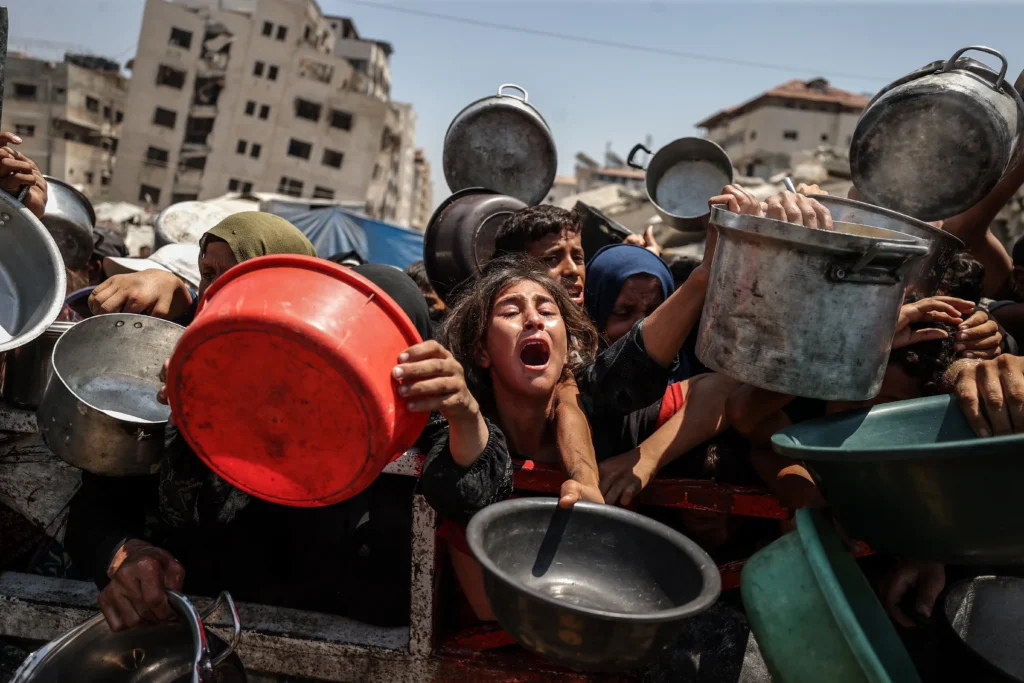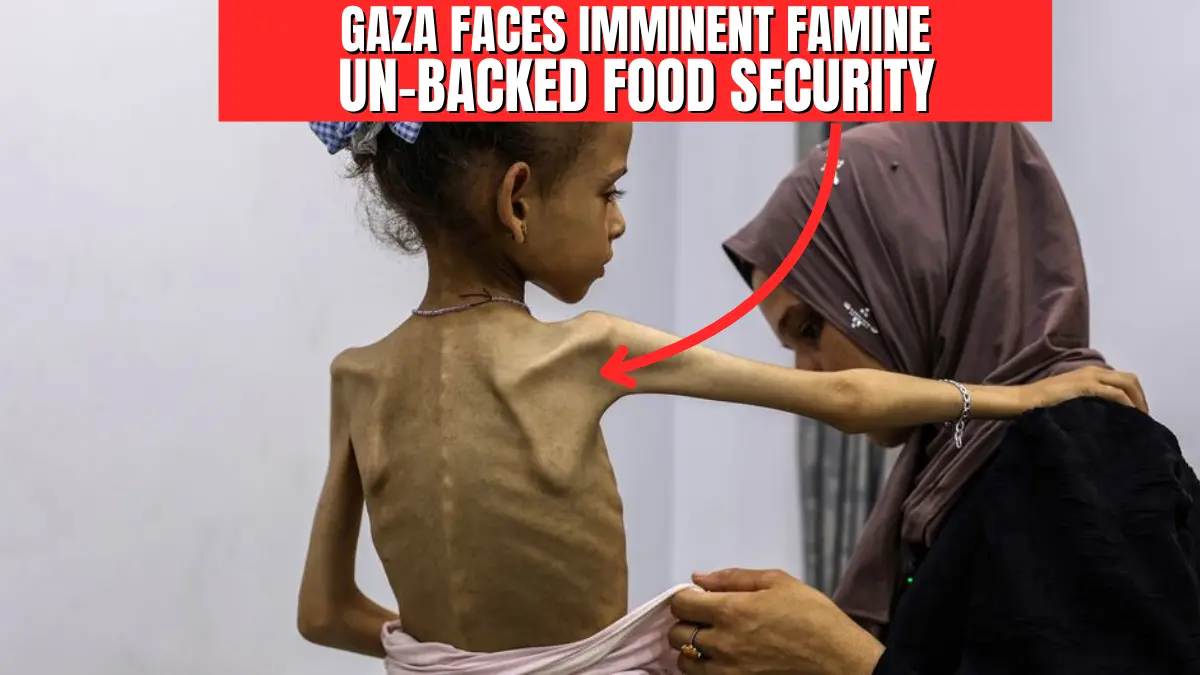A UN-backed food security group has issued its strongest warning yet: famine is unfolding in Gaza. With over 20,000 children malnourished, starvation is now a daily reality. Here’s what we know.
Table of Contents
‘Worst-case scenario of famine’ is unfolding in Gaza, UN-backed food security initiative says
A Dire Warning From the Frontlines of Starvation
A UN-backed food security agency has issued its strongest alert yet: “the worst-case scenario of famine” is unfolding in Gaza. The Integrated Food Security Phase Classification (IPC), a respected authority on global hunger emergencies, released a chilling statement highlighting skyrocketing malnutrition, disease, and death rates as the humanitarian crisis worsens across the region.
This statement comes as the international community turns its attention—some for the first time—with mounting pressure on Israel to lift its blockade and allow sustained humanitarian access.
“Mounting evidence shows that widespread starvation, malnutrition, and disease are driving a rise in hunger-related deaths,” the IPC alert read.
The Faces of Famine: Over 20,000 Malnourished Children

Between April and mid-July, over 20,000 children in Gaza were treated for acute malnutrition. Among them, over 3,000 were severely malnourished and facing potentially irreversible damage to their health. For many aid workers, doctors, and local families, this is no longer a crisis—it’s a catastrophe unfolding in slow motion.
“Famine thresholds have been reached for food consumption in most of the Gaza Strip,” the IPC said, “and for acute malnutrition in Gaza City.”
Even more disturbing: This alert isn’t a formal classification of famine—yet. But it’s the strongest signal so far that Gaza is on the brink of a large-scale hunger disaster.
Conflict, Blockade, and Collapse of Access
According to the IPC:
- Access to food and essential services has plummeted.
- Conflict and displacement have intensified.
- Health systems and supply chains are collapsing.
The ongoing blockade by Israel, combined with daily fighting between Israeli forces and Hamas militants, has made the delivery of aid incredibly difficult. Humanitarian agencies describe a grim reality where trucks full of food are either blocked, delayed, or destroyed—while families in Gaza eat grass, animal feed, or go entire days without meals.
Trump: “That’s Real Starvation Stuff”
In a rare rebuke of Israeli leadership, former U.S. President Donald Trump acknowledged the crisis bluntly on Monday.
“That’s real starvation stuff,” Trump told reporters in Turnberry, Scotland. “I see it, and you can’t fake that.”
Trump went further, announcing a plan to set up “food centers” in Gaza to tackle the deepening hunger crisis.
This came in stark contrast to Israeli Prime Minister Benjamin Netanyahu’s earlier claims that “there is no starvation in Gaza.”
U.S. Vice President JD Vance: “Really Heartbreaking Cases”
Vice President JD Vance joined the chorus of U.S. officials expressing horror over the deteriorating conditions in Gaza:
“You’ve got little kids who are clearly starving to death,” he said, calling the images “heartbreaking.”
He added that both Israel and Hamas bear responsibility—urging Israel to allow aid in and calling for efforts to prevent Hamas from hijacking aid routes.
Israel’s Tactical Pause — Too Little, Too Late?
In an apparent response to global outcry, Israel recently announced a “tactical pause in military activity” in three areas of Gaza to facilitate aid delivery. However, aid organizations say these short-term pauses are inadequate.
The UN and other groups have consistently criticized airdrops into Gaza as “inefficient, risky, and unsustainable.” Ground convoys, they argue, remain the only real solution—but require cooperation from both Israel and Hamas to succeed.
Over 60,000 Dead in Gaza
According to Gaza’s health ministry, the death toll in the territory has now surpassed 60,000, with more than 113 killed in the last 24 hours alone.
Many of these deaths are the result of starvation, collapsed healthcare systems, or indirect effects of war. Others are direct victims of Israeli airstrikes.
Authorities do not differentiate between civilians and militants in their death counts, but international agencies say the vast majority of those killed are women and children.
Genocide Accusations From Within Israel
For the first time, two leading Israeli human rights organizations have accused their own government of committing genocide in Gaza:
- B’Tselem called Israel’s actions “deliberate policy with horrific outcomes.”
- Physicians for Human Rights Israel (PHRI) accused Israel of “systematically exterminating Gaza’s health system.”
These are not small claims—they’re being made by some of the most respected civil rights voices inside Israel itself.
What Is the IPC?
The Integrated Food Security Phase Classification (IPC) is an international framework for analyzing food insecurity and famine risks. Backed by the UN and NGOs, its warnings are considered the gold standard for identifying areas on the brink of starvation.
When the IPC says a region has crossed the famine threshold, it means:
- At least 20% of the population faces extreme food shortages.
- Acute malnutrition rates are over 30%.
- Death rates are 2 people (or more) per 10,000 per day.
Gaza is now dangerously close to meeting or exceeding all three.
Global Response: More Pressure, But Little Progress
Despite growing international outrage:
- The blockade remains largely in place.
- Humanitarian corridors are unreliable.
- The war shows no sign of ending.
Efforts to broker a ceasefire stalled last week, and current diplomatic efforts have so far yielded few results.
The Path Forward: What Needs to Happen Now
The IPC and other humanitarian agencies are calling for the following:
- Immediate ceasefire to allow uninterrupted aid access.
- Full lifting or easing of the blockade on Gaza.
- Protection of medical and food aid convoys from all parties.
- Robust international monitoring to ensure aid isn’t intercepted or misused.
Anything short of these measures risks a full-blown famine affecting millions, not just tens of thousands.
Conclusion: A Moral Crossroads
Gaza is no longer just a war zone—it’s a humanitarian catastrophe. With over 60,000 dead and millions on the brink of starvation, the world faces a clear choice:
Act decisively—or watch one of the worst modern famines unfold in real time.
❓ Frequently Asked Questions (Fhttps://jobseekersconnect.com/wp-content/uploads/2025/07/Gaza-Famine_-A-Catastrophe-Unfolds.webpAQ)
Q1: What is the IPC and why is its alert significant?
The IPC is an internationally recognized authority on famine classification. Its alerts guide global responses to food crises. An alert like this signals extreme danger and imminent catastrophe.
Q2: Is Gaza officially in a state of famine?
Not officially—yet. But the IPC’s alert strongly suggests the conditions for famine are being met or exceeded in parts of Gaza.
Q3: How many people are affected?
The entire population of Gaza is facing acute food insecurity. Over 20,000 children are already being treated for malnutrition.
Q4: What is the U.S. doing to help?
President Trump has pledged to establish “food centers” in Gaza. Vice President JD Vance has called for stronger efforts to allow aid in.
Q5: Is Israel responsible for the famine?
Israel denies intentionally causing famine and says it allows aid in. However, aid groups and two Israeli human rights organizations now accuse it of policies that have directly led to mass starvation.
